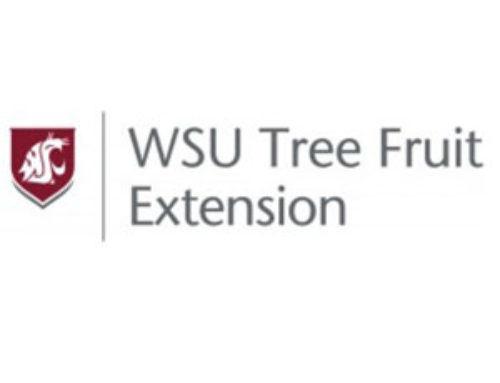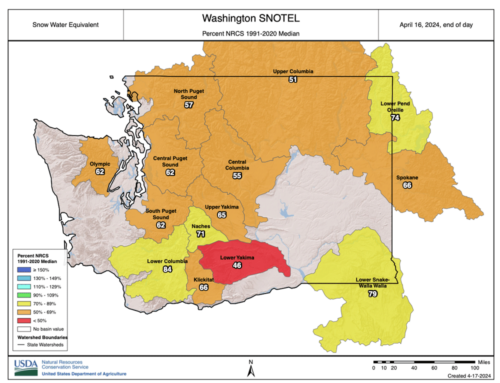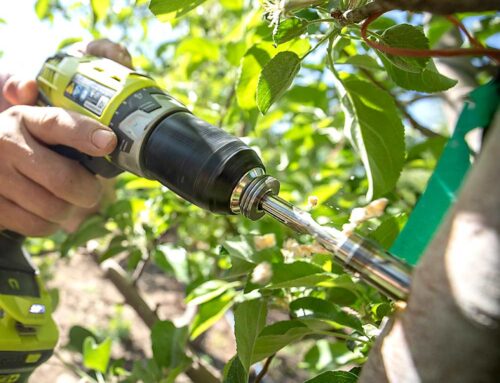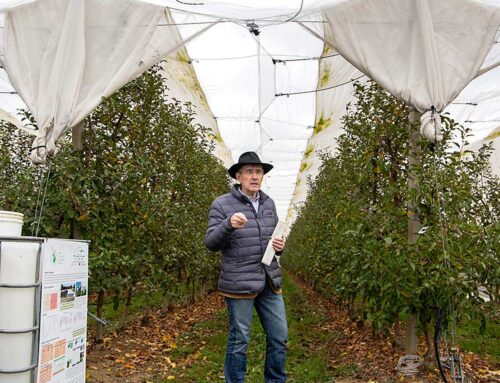How much drought can an orchard tolerate in midsummer?
The answer will vary from orchard to orchard, depending mainly on soil type, and from season to season, depending on the temperature.
Experiments done in the 1970s by Dr. Ed Proebsting, former Washington State University (WSU) horticulturist at Prosser, showed that when trees were deprived of water all season long, the only ones to die were old peach trees already in poor vigor because of winter injury.
However, the soil at the Prosser station had good water-holding capacity, and it took two months after the water was shut off for the trees to show drought symptoms.
The test plot was surrounded by irrigated blocks, from which water could have moved.
Tim Smith, WSU Cooperative Extension agent for north central Washington, said.in some orchards with shallow soil, just one missed irrigation set can affect the fruit.
Every summer, people bring to his office apples affected with what is known as drought spot. During the height of the summer, a sprinkler head will become blocked by a weed and one part of the orchard will not get irrigated during one set.
Trees in that area become severely dry and the fruit develop blotches. Smith said.drought spot is one of the most misunderstood disorders. It is not caused by a lack of boron or calcium, although those may be symptoms.
“There’s still some question how much drought you can take in the middle of summer and have good quality fruit,” he said. “Skipping a set is serious on shallow ground.” It’s critical to time irrigation properly, Smith stressed. “It’s like balancing your checkbook. Nobody enjoys it, but if you work at it, you can do it. There’s more than one way of doing it. Find a way that works for you.”
The amount of water a tree uses in a season varies a great deal, depending on the temperatures during the summer. Smith found total water use in north central Washington over the past three decades varied between a low of 30 inches in 1993 to a high of 43 inches in 1973.
Growers need to be ready to adapt to the circumstances, and should aim to replenish soil moisture when it is about 50 percent depleted, he suggested.
The interval between irrigations will depend on the water-holding capacity of the soil and the tree’s water use, which can be calculated from evapotranspiration rates.
Growers also need to know how much water their irrigation system is applying. Instructions for calibrating application rates are available from Smith. Efficiency of the system must be taken into account. The least efficient is an overtree sprinkler system, which may be only 50 percent efficient on a hot, windy day.
“When you need to water the most, it’s the least efficient,” he said. “Most of the water is lost by evaporation.”
Microsprinklers are about 80 to 95 percent efficient, but exceptionally good weed control is needed to avoid weeds blocking the sprinkler pattern. An undertree solid set system is about 70 percent efficient.
Soil moisture
Soil wetness should be monitored, to check assumptions.
Soil moisture measuring devices can be used, or soil wetness can be observed by feeling and squeezing the soil.
Some orchards in Chelan don’t need to irrigate because water travels down from orchards on the hill above.
Smith said.until the growers began monitoring their soil moisture they didn’t know they didn’t need to irrigate. A professional irrigation scheduling service can monitor moisture using accurate equipment, and generate reports, Smith said.
“They are not that expensive. If you’re trying to get by on the last gallon of water, it would be a good investment to have someone come in and do that.”
When it’s time to irrigate, the surface of the soil should look dry. The second foot should be less dry, and the third foot should be quite moist.
“When the top six inches are dry, there’s nothing wrong with that,” he said. “When it’s dry in the top foot, you should be irrigating.”
A person who irrigates on a set schedule throughout the season, without regard to water use, will only apply the correct amounts two times, he pointed out.
“Every other time of the year, your set length will be wrong.”
Summer
Between mid-June and mid-August–when humidity is low, the sun is hot, and the days are long–the trees use water at the highest rate. Cell division is complete, and the fruit is sizing. Cells need sugar and water to enlarge.
They do not need nitrogen, Smith emphasized. Fertilizer applied in the summer does not make fruit larger, but it might hurt the quality of the fruit by making it greener. Most of the water a tree uses is lost through the leaves.
During the day, when transpiration is high, water moves from the fruit back into the tree and the fruit shrinks. At night, as the tree catches up with its water needs by taking more moisture out of the ground, the fruit swells up again.
It’s important that the tree is always able to rehydrate, Smith said. If a tree is still wilted in the morning, it shows that the tree has not been replenished with water and will go into the day already dehydrated. As little as three days of serious stress during the summer can impact the fruit, Smith said.
“Total stress adds up during the season, and at the end of the season, at harvest time, you have to pay the bill.”
As leaves draw water from the fruit, calcium is also lost, which can lead to calcium-related disorders such as bitter pit and cork spot, Smith warned.
“When we have a hot, stressful summer, the amount of cork spot and bitter pit goes up. Keeping stress down on the tree helps reduce the amount of calcium-related disorders in the packing house.”
Moisture stress in Bartlett pears during the last three to four weeks of harvest can lead to black end or pink end, or premature ripening, depending on the degree of stress, Smith said. In Red Delicious, stress can make fruit round, rather than typy.
This is because when water leaves the fruit, it leaves the calyx end first, and when it returns to the fruit, it reaches the calyx end last.
Fall
There’s a tendency to overirrigate during the period from mid-August to October. Although it may still be hot, the trees sense the end of summer by the shortening days and will be using half as much water before the end of September.
“Making the soil sopping wet doesn’t make the fruit get bigger. In fact, we think it hurts quality. By the time we’re harvesting pears and into Gala season, the water use has gone way down. What a Fuji needs around here is heat, not water, by the time you get into October.” For more information, check the Web site at www.ncw.wsu.edu/tftindx.htm.






Leave A Comment